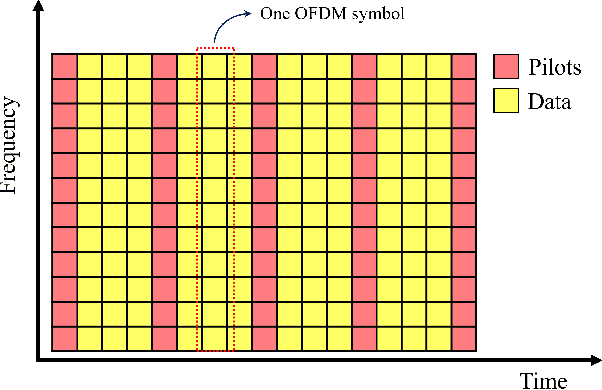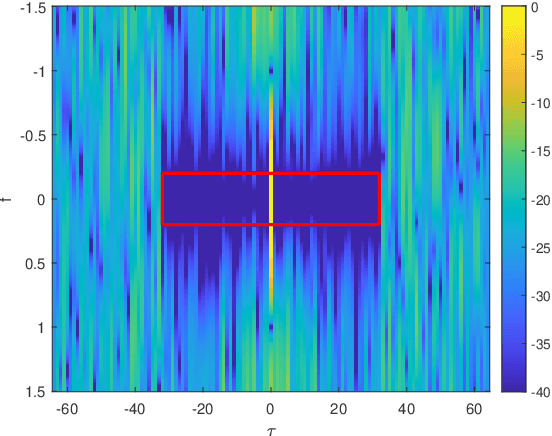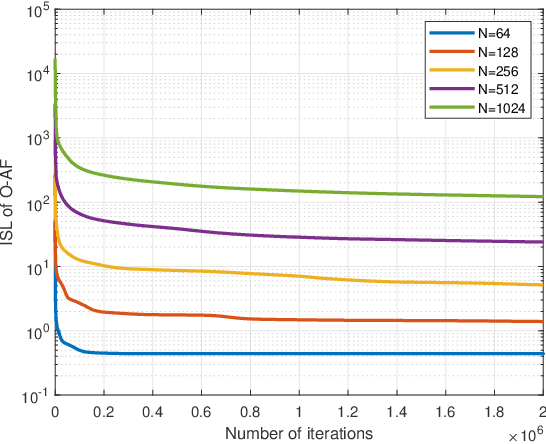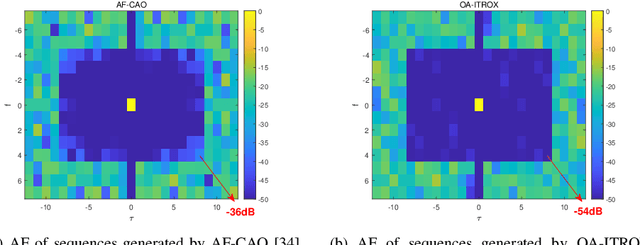Pingzhi Fan
A Gradient Meta-Learning Joint Optimization for Beamforming and Antenna Position in Pinching-Antenna Systems
Jun 14, 2025Abstract:In this paper, we consider a novel optimization design for multi-waveguide pinching-antenna systems, aiming to maximize the weighted sum rate (WSR) by jointly optimizing beamforming coefficients and antenna position. To handle the formulated non-convex problem, a gradient-based meta-learning joint optimization (GML-JO) algorithm is proposed. Specifically, the original problem is initially decomposed into two sub-problems of beamforming optimization and antenna position optimization through equivalent substitution. Then, the convex approximation methods are used to deal with the nonconvex constraints of sub-problems, and two sub-neural networks are constructed to calculate the sub-problems separately. Different from alternating optimization (AO), where two sub-problems are solved alternately and the solutions are influenced by the initial values, two sub-neural networks of proposed GML-JO with fixed channel coefficients are considered as local sub-tasks and the computation results are used to calculate the loss function of joint optimization. Finally, the parameters of sub-networks are updated using the average loss function over different sub-tasks and the solution that is robust to the initial value is obtained. Simulation results demonstrate that the proposed GML-JO algorithm achieves 5.6 bits/s/Hz WSR within 100 iterations, yielding a 32.7\% performance enhancement over conventional AO with substantially reduced computational complexity. Moreover, the proposed GML-JO algorithm is robust to different choices of initialization and yields better performance compared with the existing optimization methods.
Cross-Frame OTFS Parameter Estimation Based On Chinese Remainder Theorem
Apr 07, 2025Abstract:Orthogonal time-frequency space (OTFS) is a potential waveform for integrated sensing and communications (ISAC) systems because it can manage communication and sensing metrics in one unified domain, and has better performance in high mobility scenarios. In practice, a target might come from far distance or with ultra-high speed. However, the max unambiguous range and max tolerable velocity of OTFS-ISAC system is limited by the unambiguous round-trip delay and Doppler shift, which are related to OTFS frame, i.e., time slots and subcarrier spacing, respectively. To enlarge the sensing range, a novel OTFS cross-frame ranging and velocity estimation model as well as its corresponding method based on the Chinese remainder theorem (CRT) are proposed in this paper. By designing co-prime numbers of subcarriers and time slots in different subframes, the difference in the responses of the subframes for a target can be used to estimate the distance and velocity of an out-of-range target. Several frame structures are further designed for specific sensing scenarios, such as target with ultra-high speed or at far distance. Simulation results show that the proposed method can achieve significantly better performance in NMSE compared with the classic sensing methods under the condition of same time and frequency resources.
Waveform and Filter Design for Integrated Sensing and Communication Against Signal-dependent Modulated Jamming
Mar 19, 2025Abstract:This paper focuses on an integrated sensing and communication (ISAC) system in the presence of signal-dependent modulated jamming (SDMJ). Our goal is to suppress jamming while carrying out simultaneous communications and sensing. We minimize the integrated sidelobe level (ISL) of the mismatch filter output for the transmitted waveform and the integrated level (IL) of the mismatch filter output for the jamming, under the constraints of the loss in-processing gain (LPG) and the peak-to-average power ratio (PAPR) of the transmitted waveform. Meanwhile, the similarity constraint is introduced for information-bearing transmit waveform. We develop a decoupled majorization minimization (DMM) algorithm to solve the proposed multi-constrained optimization problem. In contrast to the existing approaches, the proposed algorithm transforms the difficult optimization problem involving two variables into two parallel sub-problems with one variable, thus significantly speeding up the convergence rate. Furthermore, fast Fourier transform (FFT) is introduced to compute the closed-form solution of each sub-problem, giving rise to a greatly reduced computation complexity. Simulation results demonstrate the capabilities of the proposed ISAC system which strikes a proper trade-off among sensing and jamming suppression.
Low-PAPR OFDM-ISAC Waveform Design Based on Frequency-Domain Phase Differences
Mar 17, 2025Abstract:Low peak-to-average power ratio (PAPR) orthogonal frequency division multiplexing (OFDM) waveform design is a crucial issue in integrated sensing and communications (ISAC). This paper introduces an OFDM-ISAC waveform design that utilizes the entire spectrum simultaneously for both communication and sensing by leveraging a novel degree of freedom (DoF): the frequency-domain phase difference (PD). Based on this concept, we develop a novel PD-based OFDM-ISAC waveform structure and utilize it to design a PD-based Low-PAPR OFDM-ISAC (PLPOI) waveform. The design is formulated as an optimization problem incorporating four key constraints: the time-frequency relationship equation, frequency-domain unimodular constraints, PD constraints, and time-domain low PAPR requirements. To solve this challenging non-convex problem, we develop an efficient algorithm, ADMM-PLPOI, based on the alternating direction method of multipliers (ADMM) framework. Extensive simulation results demonstrate that the proposed PLPOI waveform achieves significant improvements in both PAPR and bit error rate (BER) performance compared to conventional OFDM-ISAC waveforms.
Linear Precoding Design for OTFS Systems in Time/Frequency Selective Fading Channels
Dec 31, 2024

Abstract:Even orthogonal time frequency space (OTFS) has been shown as a promising modulation scheme for high mobility doubly-selective fading channels, its attainability of full diversity order in either time or frequency selective fading channels has not been clarified. By performing pairwise error probability (PEP) analysis, we observe that the original OTFS system can not always guarantee full exploitation of the embedded diversity in either time or frequency selective fading channels. To address this issue and further improve system performance, this work proposes linear precoding solutions based on algebraic number theory for OTFS systems over time and frequency selective fading channels, respectively. The proposed linear precoded OTFS systems can guarantee the maximal diversity and potential coding gains in time/frequency selective fading channels without any transmission rate loss and do not require the channel state information (CSI) at the transmitter. Simulation results are finally provided to illustrate the superiority of our proposed precoded OTFS over both the original unprecoded and the existing phase rotation OTFS systems in time/frequency selective fading channels.
Oversampled Low Ambiguity Zone Sequences for Channel Estimation over Doubly Selective Channels
Sep 26, 2024



Abstract:Pilot sequence design over doubly selective channels (DSC) is challenging due to the variations in both the time- and frequency-domains. Against this background, the contribution of this paper is twofold: Firstly, we investigate the optimal sequence design criteria for efficient channel estimation in orthogonal frequency division multiplexing systems under DSC. Secondly, to design pilot sequences that can satisfy the derived criteria, we propose a new metric called oversampled ambiguity function (O-AF), which considers both fractional and integer Doppler frequency shifts. Optimizing the sidelobes of O-AF through a modified iterative twisted approximation (ITROX) algorithm, we develop a new class of pilot sequences called ``oversampled low ambiguity zone (O-LAZ) sequences". Through numerical experiments, we evaluate the efficiency of the proposed O-LAZ sequences over the traditional low ambiguity zone (LAZ) sequences, Zadoff-Chu (ZC) sequences and m-sequences, by comparing their channel estimation performances over DSC.
Grid Evolution for Doubly Fractional Channel Estimation in OTFS Systems
Sep 26, 2024



Abstract:In orthogonal time-frequency space communications, the performances of existing on-grid and off-grid channel estimation (CE) schemes are determined by the delay-Doppler (DD) grid density. In practice, multiple real-life DD channel responses might be co-located within a same DD grid interval, leading to performance degradation. A finer grid interval is needed to distinguish these responses, but this could result in a significantly higher CE complexity when traditional methods are used.To address this issue, a grid evolution method for doubly fractional CE is proposed by evolving the initially uniform coarse DD grid into a non-uniform dense grid. Simulation results show that our proposed method leads to improved computational efficiency, and achieves a good trade-off between CE performance and complexity.
Dual-Functional Waveform Design with Local Sidelobe Suppression via OTFS Signaling
Apr 30, 2024Abstract:Integrated sensing and communication (ISAC) is viewed as a key technology in future wireless networks. One of the main challenges in realizing ISAC is developing dual-functional waveforms that can communicate with communication receivers and perform radar sensing simultaneously. In this paper, we consider the joint design of a dual-functional orthogonal time-frequency space (OTFS) signal and a receiving filter for the ISAC system. The problem of ISAC waveform design is formulated as the minimization of the weighted integrated sidelobe level (WISL) of the ambiguity function and the interference term from ISAC waveform, with constraints on signal-to-noise ratio loss. The majorization-minimization algorithm combined with alternating iterative minimization is implemented to solve the optimization problem. Simulation results show that the WISL and the interference term can be significantly decreased to guarantee achievable data rates and detection performance.
Next Generation Multiple Access for IMT Towards 2030 and Beyond
Apr 05, 2024
Abstract:Multiple access techniques are fundamental to the design of wireless communication systems, since many crucial components of such systems depend on the choice of the multiple access technique. Because of the importance of multiple access, there has been an ongoing quest during the past decade to develop next generation multiple access (NGMA). Among those potential candidates for NGMA, non-orthogonal multiple access (NOMA) has received significant attention from both the industrial and academic research communities, and has been highlighted in the recently published International Mobile Telecommunications (IMT)-2030 Framework. However, there is still no consensus in the research community about how exactly NOMA assisted NGMA should be designed. This perspective is to outline three important features of NOMA assisted NGMA, namely multi-domain utilization, multi-mode compatibility, and multi-dimensional optimality, where important directions for future research into the design of NOMA assisted NGMA are also discussed.
STAR-RIS Aided Integrated Sensing and Communication over High Mobility Scenario
Mar 18, 2024Abstract:Integrated sensing and communication (ISAC) has become a promising technology for future communication system. In this paper, we consider a millimeter wave system over high mobility scenario, and propose a novel simultaneous transmission and reflection reconfigurable intelligent surface (STAR-RIS) aided ISAC scheme. To improve the communication service of the in-vehicle user equipment (UE) and simultaneously track and sense the vehicle with the help of nearby roadside units (RSUs), a STAR-RIS is equipped on the outside surface of the vehicle. Firstly, an efficient transmission structure is developed, where a number of training sequences with orthogonal precoders and combiners are respectively utilized at BS and RSUs for channel parameter extraction. Then, the near-field static channel model between the STAR-RIS and in-vehicle UE as well as the far-field time-frequency selective BS-RIS-RSUs channel model are characterized. By utilizing the multidimensional orthogonal matching pursuit (MOMP) algorithm, the cascaded channel parameters of the BS-RIS-RSUs links can be obtained at the RSUs. Thus, the vehicle localization and its velocity measurement can be acquired by jointly utilizing these extracted cascaded channel parameters of all RSUs. Note that the MOMP algorithm can be further utilized to extract the channel parameters of the BS-RIS-UE link for communication. With the help of sensing results, the phase shifts of the STAR-RIS are delicately designed, which can significantly improve the received signal strength for both the RSUs and the in-vehicle UE, and can finally enhance the sensing and communication performance. Moreover, the trade-off for sensing and communication is designed by optimizing the energy splitting factors of the STAR-RIS. Finally, simulation results are provided to validate the feasibility and effectiveness of our proposed STAR-RIS aided ISAC scheme.
 Add to Chrome
Add to Chrome Add to Firefox
Add to Firefox Add to Edge
Add to Edge